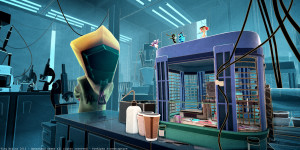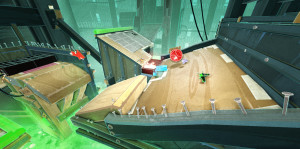Tiny Brains Meets Big Adventures – Preview of Tiny Brains
If you haven’t heard about Spearhead Games, then in the coming months (or perhaps years), you are guaranteed to! This dedicated team of developers left their respective jobs and formed their dream company in 2011. The three co-owners of Spearhead Games are Simon Darveau (formerly from Ubisoft), Malik Boukhira (also formerly from Ubisoft), and Atul Mehre (formerly from EA). These incredibly talented people decided to move beyond the Assassin’s Creed series and Army of Two to develop a game that would transcend set age groups or gamer skill levels. Tiny Brains is an up-and-coming title hoping to be released by the end of 2013, and Gamer Living got to speak with Spearhead Games and learn more about this under-hyped game heading to the market this year!
There are four main characters available for this co-operative puzzler: Minsc (the hamster), Pad (the rat), Stew (the rabbit), and Dax (the bat). Each character has their own unique abilities that will be useful to further you in the game! Pad can teleport, Minsc can create objects, Stew can create a vortex, and Dax can use the force (think Star Wars, young Padawan)! These four squishy little super-experiments are trying to escape from a mad scientist’s evil lab, fighting his minions and deadly obstacles along their way.
The game transitions seamlessly, so that you can play a solo campaign or invite up to three more friends to join you whenever you’d like. You can switch characters or add and remove players at any time during play, without losing any progress! Even if someone in your party has to leave, it doesn’t mean the end of your gameplay! This means that all characters are available at any time and can be utilized to accomplish any in-game goals, regardless of how many people are playing. To add even more adaptability to Tiny Brains, the puzzles will instantly change to accommodate the number of players, so the difficulty will be even, no matter how many people are in the session.
 While I was speaking with the developers, a large group of guys was sitting around, playing the game, off to the side on a couch. Quickly, things escalated, and we had to move over to talk as they were jumping up and down, screaming and high-fiving each other. Simon remarked that he absolutely loved watching players’ reactions, especially when people who didn’t know each other were playing together. They would start off shy and eventually be talking to one another, and even high-fiving and cheering one another on. The game is meant to create that communal atmosphere that doesn’t exist in the same form that it used to.
While I was speaking with the developers, a large group of guys was sitting around, playing the game, off to the side on a couch. Quickly, things escalated, and we had to move over to talk as they were jumping up and down, screaming and high-fiving each other. Simon remarked that he absolutely loved watching players’ reactions, especially when people who didn’t know each other were playing together. They would start off shy and eventually be talking to one another, and even high-fiving and cheering one another on. The game is meant to create that communal atmosphere that doesn’t exist in the same form that it used to.
Remember back in the days of dial-up, when you called a friend to come over and play games? Then you would sit on the couch together and play co-operative titles, trolling each other or cheering each other on while you experienced the game as a team. This is the feeling that people will get while playing Tiny Brains. Watching different people sit down and give the game a spin, it becomes quite obvious that it can be enjoyed by players of all skill levels.
Although Tiny Brains was still in its Alpha Stage, we were impressed with how sophisticated it looked! It was surprising, as quite a few of us thought it was a final product that we were watching and playing. The characters themselves are fuzzy little cartoon animals, with brightly coloured fur and little Band-Aids or electronic devices sticking out of their clothes or attached to their bodies. The gameplay is no different than the characters, set in a bright, cartoony and enlarged atmosphere. Here you’ll see our little lab experiments running on levels that look like giant cardboard boxes as platforms, or hamster tubes laid out like an obstacle course. You’ll also be fighting bodiless orange and red minions (which appear to be rooster heads), who are chasing after you on behalf of the evil scientist who has imprisoned you! Most of the game looks like it will be played with an overhead view, panning to a side view of the level every once in a while. Overall, the game has a polished, animated look that you tend to see in newer children’s movies (think Despicable Me), which makes Tiny Brains seem a little more carefree than trying to escape with your life from an evil laboratory!
 Even if you aren’t a fan of puzzlers, this game lends itself to action adventure as well. Many of the levels will involve running and jumping around dangerous obstacles, such as falling floors or fiery explosions. That being said, the characters are bulletproof and fireproof, making this cartoony adventure free from blood and gore. The gameplay mechanics are very intuitive, with simple goals or challenges to complete in each level (such as moving different shapes to corresponding floor tiles, or working as a team to roll a ball as high as you can while using the characters’ unique skills to avoid pitfalls). What makes Tiny Brains fun is that it urges people to problem-solve on their toes, often requiring them to think outside of the box and tackle obstacles cooperatively. For example, in one level the characters were tasked with protecting a cute pink chick from the attacking rooster heads. As Minsc, you could create a large block and bulldoze the minions into fiery pits or squish them against a wall, whereas Dax could just force-push the enemies into the nearest grinder.
Even if you aren’t a fan of puzzlers, this game lends itself to action adventure as well. Many of the levels will involve running and jumping around dangerous obstacles, such as falling floors or fiery explosions. That being said, the characters are bulletproof and fireproof, making this cartoony adventure free from blood and gore. The gameplay mechanics are very intuitive, with simple goals or challenges to complete in each level (such as moving different shapes to corresponding floor tiles, or working as a team to roll a ball as high as you can while using the characters’ unique skills to avoid pitfalls). What makes Tiny Brains fun is that it urges people to problem-solve on their toes, often requiring them to think outside of the box and tackle obstacles cooperatively. For example, in one level the characters were tasked with protecting a cute pink chick from the attacking rooster heads. As Minsc, you could create a large block and bulldoze the minions into fiery pits or squish them against a wall, whereas Dax could just force-push the enemies into the nearest grinder.
Still unconvinced? Take a look at the trailer released in time for E3! Tiny Brains is the type of game that quietly stood in the background while bigger companies like Nintendo and Konami blared their music and flashed their AAA trailers at the crowd. For those of us who wandered around curiously for little booths with big potential, we hit the jackpot finding Spearhead Games. Keep an eye out for updates about this game, and prepare yourselves for a company that is bound to see exponential growth in their fan base very soon!
**This was written collaboratively with Victoria Liu-Anderson
About This Post
